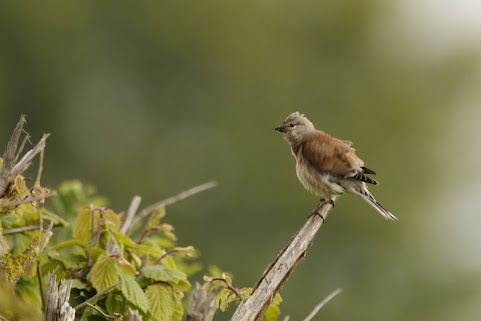The Breeding Bird Survey is a scheme that documents the highs and lows of breeding birds across the country. Run by the British Trust for Ornithology (BTO), it entails walking a transect, and noting all the birds that are seen as you do so. As you walk the transect, you record the birds out to the sides, and their distance, and whether singing or in flight. After you finish you then log the results online, and this will give a picture of the bird's fortunes in your transects over time. My transect happened to be just off the A1120, the Stowemarket road, which lies just across the road from Stonham Barns. It follows a farm track that winds its way through fields of rape, with a border of low cut hedgerow, and with the odd tree sprouting up. It ended with a set of farm buildings, which provided a different habitat. The survey entails two visits a year, four weeks apart, in Spring. This is the second of two visits, my first was in 21 April which I wrote a different blog entry for.
The most difficult thing about the survey was having to get up early in the morning, right up at the crack of dawn. I was able to get to the site at half five, walked up and down the track and finished by seven, leaving me free for the rest of the day. At least the the weather was in my favour this visit. Although not particularly warm, it was early in the morning after all, the visibility was good, no wind, and not much cloud cover. On my last visit in April there was wall to wall fog, and I saw nothing, typical.
All in all twenty species of bird were see in total on both trips, fourteen of them today. Being just intensively farmed land there were few birds encountered in the transect. Common birds like the great tit weren't recorded as there was no woodland or scrub. Considering the habitat it was fairly obvious that the most recorded types were those of farmland birds. LINNET were the most numerous bird, followed by YELLOWHAMMER. Set-aside plots cut through areas of the rape by the farmer meant there were decent numbers of SKYLARKS, serenading me with their beautiful song.
I also happened to see some HARES on my visit, I think at least five individuals. This is the usual kind of habitat for this mammal and the animals would run out of the rape fields, onto the track before seeing me and disappearing again. Hares are great to see, the diamond in farming county. As well as the birds I am also obliged to record all mammal sightings I see in the area as well.
Its always good to use my bird identification skills for some good, to have some use for a lifetime of bird watching. Surveys like this rely on volunteers to provide the sightings that will end up being turned into an official report. Taking part in these surveys really makes you feel like your a proper birdwatcher, that you you've made it. Although its early days, I think this Spring, with its topsy-turvey weather has been a very poor one. Hopefully this is just a one off and next spring will see a return to normal.





No comments:
Post a Comment